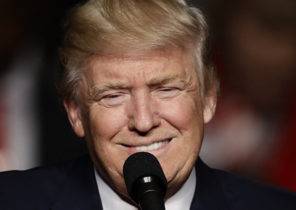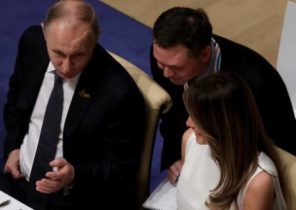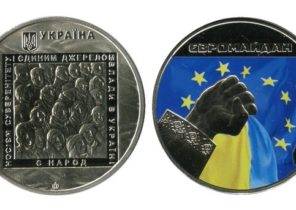Two years ago, in his address to the nation before the presidential election of Vladimir Putin by video and animations has introduced a new superweapon Russia.
“Nobody wanted basically to talk to us”, — said Putin about NATO expansion to the East. “No one listened to us”.
The President showed underwater drones, missiles and nuclear weapons and assured that the new system is invincible.
“Listen now,” retorted Putin.
After a few billion rubles, some of them are already on duty, but others have not yet got off the drawing Board.
In the Victory Parade on 24 June to take part only one of the new hypersonic missile, which will carry fighter. The rest of the superweapons will have to wait.
Weapons like a business card
“The leitmotif of the Russian armed forces in the development of new weapons is to bypass the existing missile defense system,” says Pentti forsström was (Pentti Forsström), a specialist on Russia at the National defense University.
“Russia is committed to technological superiority and thus tries to increase the credibility of its military power,” continues forsström was.
Norberg of Johan (Johan Nordberg) from Swedish Institute of defense research in Stockholm stressed that these projects will go a long way from digital presentation to the deployment of the troops.
“But it is important that Russia continues to develop new opportunities,” says Norberg.
“In the great war can this weapon be used to strike behind enemy lines. For example, during the war in Europe, you can hit ports in the Atlantic”.
At the same time, Norberg emphasizes that to focus on new types of weapons is not worth it.
“If you look at the overall military potential of Russia, to the forces that can actually fight, the new systems still little,” he says.
“The main strength accounts for the totality of the armed forces: a large army supported by air force and Navy. And, of course, the main role is played by strategic nuclear Arsenal,” he says.
Trump has to catch up
“I think that we will be able to surprise our partners that when they have these weapons will appear, with high probability we will have a means of combating these weapons”, — Putin said a week ago in an interview with state television.
According to the President, Russia had to start the development of hypersonic weapons after the United States terminated the agreement on missile defence in 2002.
“If Russia has not recovered, it didn’t take its worthy position in the world, the world would be a worse and more dangerous”, — he said.
In this context, there are two new superweapons: the “avant-garde” and “Zircon”.
Avangard — hypersonic Intercontinental system, which can be equipped with nuclear weapons. The first “avant-garde” entered service in the winter of 2019.
“”Avant-garde” is still in the testing stage, and only a few pieces,” explains Pentti forsström was.
According to the Russian Ministry of defense over the next decade, “vanguard” gradually replace their predecessors.
“Zircon” — a hypersonic cruise missile to destroy targets at sea. Her tests are also in progress.
“Sarmat” and “Dagger”
“From the weapons that was announced by the President, have advanced Sarmat” — says forsström was from the National defense University. The rocket will be on duty next year.
“Sarmat” — Intercontinental ballistic missile with a range of 18 000 km Missile can be equipped with all types of warheads, including nuclear.
“Sarmat” will replace missile complex “Governor” — he is considered a bit old-school.
“The dagger, it seems, too, is already in service,” says Norberg from Swedish Institute of defense research.
“Dagger” — a hypersonic ballistic missile airborne. In recent years, the missile has undergone extensive testing and has a range of up to 2,000 km.
In addition, the “Dagger” is the only Putin’s weapons that appear in the Victory Parade in Moscow June 24.
“These new projects of a peaceful political benefit,” he Nurberg. “You can scare the world and at the same time to convince her, what Russia is big and strong.”
The military benefit is somewhat different.
“It is important to remember that a significant part of the current Russian weaponry is still Soviet,” said Norberg. “We should not forget about the old weapons systems, mostly concentrated on land forces.”
Drones in the ocean
Superweapon “Poseidon” often glimpsed in the Russian media. “Poseidon” Intercontinental torpedo or drone on nuclear-powered, which can quickly navigate through the ocean column.
The torpedo can carry a variety of warheads, including nuclear.
Military analyst Viktor Baranets believes that “Poseidon” can “easily circumnavigate the globe and to Balk the enemy’s side to inflict the greatest damage”, and “approaching the enemy coast quietly bury in the mud, where no one can find out and will wait for the combat team.”
“Poseidon” will create not only a giant explosion, but a tsunami that will flood the court and the whole city.
Ways to protect yourself from the “Poseidon” is not in the next 100 years are expected.
However, other experts criticized Poseidon for being slow and noise, thinking that it would be easy to detect.
According to the Russian news Agency RIA first test “of Poseidon” will be held next fall. Thus the same Agency reports that the system does not yet exist as a single unit, and tested only parts of it.
When or if “Poseidon” to be realized, the torpedo will be part of the Arsenal of new submarines of the “Khabarovsk” and “Belgorod”.
The other two superweapons of the President, on the contrary, is very quiet — this is a laser system “Peresvet” and cruise missiles “savages”.
Rockets
According to a report published by the Swedish Institute for defence studies last winter, nuclear deterrence will continue to play a pivotal role in Russian military strategy.
However, the report notes that in recent years Russia has started to focus on non-nuclear deterrent based on cruise missiles.
“This is a substantial investment,” says Norberg. “And they are built on a clear strategy.”
“The focus of our attention is a large-scale war and to military pressure on the enemy such as NATO or China, Russia will not have enough missiles, especially equipped with conventional warheads,” explains Norberg.
Critical pressure, apparently, would require nuclear weapons.
National defence University in Helsinki is also closely following this trend.
“In practice, nuclear weapons are useless because it is destructive for all parties,” — said forsström was. So Russia is developing weapons more useful and also cheaper.
In addition, these missiles are not regulated by international agreements.
Report of the Swedish Institute for defence studies “powerful potential” of the Russian armed forces called their online remote battlefield in the form of ballistic and cruise missiles.
The number of missiles for ranged for the last three years has increased significantly — mainly due to the deployment of systems like “Gauge” and “Iskander”.
The Institute finds that the number of platforms, armed with cruise missiles, over the next decade is likely to rise significantly.
Norberg, however, emphasizes that we should not forget the traditional weapons.
“Russia’s neighboring countries should consider the overall deterrent capability, and not to focus on the new cruise missiles,” he concludes.







